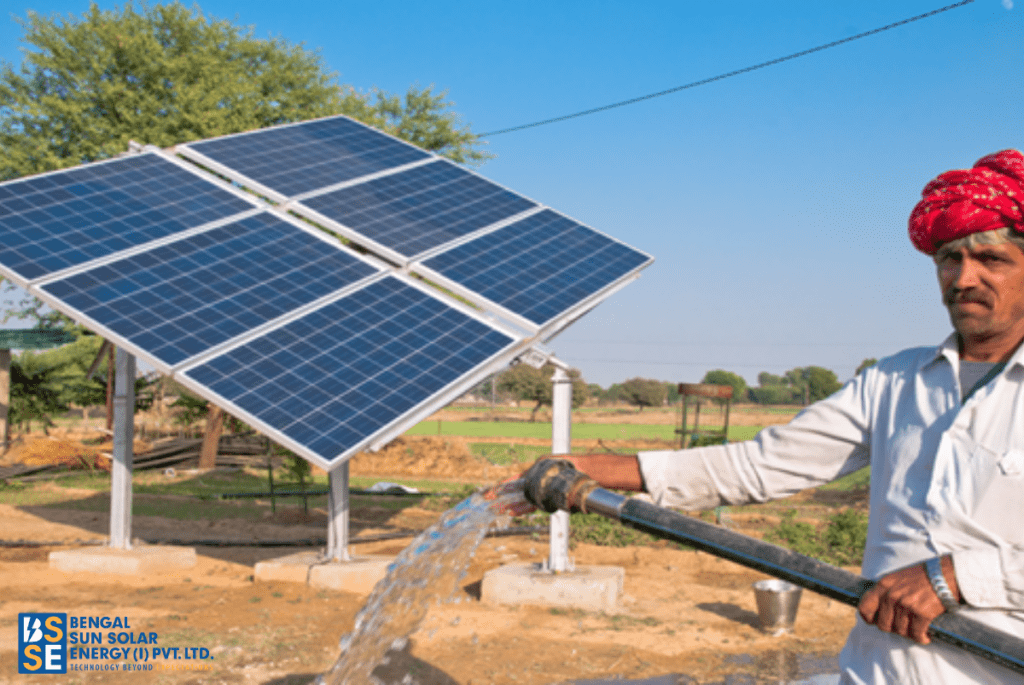Irrigation to the farmers in the paddy fields of the Siliguri and Jalpaiguri districts of West Bengal is always a matter of great concern. Located in India’s northeast, the area is famous for its scenic beauty, tea plantations and paddy fields. While the region’s fertile soil makes it ideal for a variety of crops, it is almost entirely dependent on rainfall for irrigation, like anywhere else in the world.
To reduce their dependence on the monsoons, India’s farmers have taken 12 million electricity connections and 9 million diesel pump sets with which they pump up groundwater for irrigation.
Since more than half of India’s cultivated land is yet to be irrigated, a business-as-usual scenario will lead to a huge rise in India’s energy needs for agriculture alone.
But there is an alternative—solar energy: With decreasing solar modules prices, solar pumps are fast becoming a viable financial solution for irrigation.
Won’t solar pumps only make farmers more lax about using energy resources and wasting groundwater?
One could argue that, with solar power, the problem could get worse. Since solar power is abundant in India, farmers could feel even less obligated to monitor the use of solar pumps, leading to even lower groundwater levels.
Also, a World Bank irrigation project in West Bengal is exploring a service contract model for solar pumps, where payments are made to the contractor depending on the amount of water delivered from the pumps. This can be monitored through inexpensive GPRS and remote sensing technologies. This business model can help put a price on the use of water and help maintain ground water levels if the government sets and enforces proper limits. The project is also looking at using solar pumps, small agro-mills and drying crops during non-irrigation season.
Aren’t costs to install and operate solar pumps prohibitive?
But one must think about the long-term returns. The cost of running a solar pump is virtually zero. It can pump water for at least 25 years with little overhead and management costs. A solar pump is clearly the more viable option in the long run and once commercial and public banks in India start lending to install them; it could have a significant impact on the lives of farmers.
Is solar energy reliable in all seasons?
In many parts of India, there are 60-70 days in a year when weather conditions (clouds) prevent solar water pumps from working. But it rains a lot of those days, so irrigation may not be necessary then. That still leaves a few days where you might not see the sun, leaving about a 90% reliability factor for solar water pumping. But adding energy or water storage could offset that issue. Also, small land holdings reduce the applicability of larger solar pumps unless water brought up by using solar pumps can be shared among a group of farmers.
Are solar pumps environment friendly?
India uses more than 4 billion liters of diesel (13% of total diesel consumption in India) and around 85 million tons of coal per annum (19% of total coal consumption in India) to support water pumping for irrigation. If 50% of these diesel pumps were replaced with solar PV pump sets, diesel consumption could be reduced by about 225 million liters/year (7.5% of total diesel consumption in India).
Bengal Sun Solar Energy (I) Private Ltd is one company committed on using the application of solar energy in all spheres, including the agricultural sector. Their expertise and deep knowledge makes them the top solar panel manufacturer in West Bengal.
